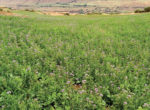Advertise Follow Us
Cover Crops
What I've Learned from No-Tilling
Adding Diversity and Livestock for a Stronger Bottom Line — Now and in the Future
Playing the long game means this no-tiller’s profits may be more impressive when viewed by the decade rather than the year.
Read More
No-Tilling Organic Soybeans with Spring-Interseeded Cereal Rye
More and more growers are experimenting with no-tilling organic soybeans. New research shows interseeding cereal rye in spring can improve weed suppression, but timing, row spacing and good stand establishment play a critical role.
Read More










